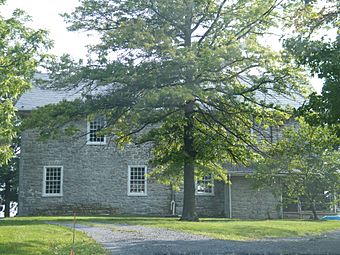Hopewell Friends Meeting House (Frederick County, Virginia) facts for kids
|
Hopewell Friends Meeting House
|
|

Hopewell Friends Meeting House, September 2011
|
|
| Nearest city | Clear Brook |
|---|---|
| Area | 8 acres (3.2 ha) |
| Built | 1759–1761 (original) 1788–1794 (expansion) |
| Built by | Thomas McClun |
| NRHP reference No. | 80004190 |
Quick facts for kids Significant dates |
|
| Added to NRHP | March 28, 1980 |
The Hopewell Friends Meeting House is a historic building from the 1700s. It is a meeting house for Quakers, a type of Christian group. You can find it in northern Frederick County, Virginia, near the town of Clear Brook. This area was once home to Thomas William "Tom" Fox, a Quaker peace activist who worked with Christian Peacemaker Teams.
Contents
Exploring the History of Hopewell Meeting House
How Hopewell Meeting Started
The Hopewell Friends Meeting began in 1734. It was first called "Opeckan" after a nearby creek. This makes it the oldest Quaker meeting in Virginia's Shenandoah Valley. Many of the first Quaker families came from Pennsylvania and Maryland.
An old record from May 18, 1734, shows that "Alexander Ross hath proposed... that a meeting for worship may be settled amongst them." This means the community wanted a place to gather and worship. At first, this meeting was part of the Philadelphia Yearly Meeting. About seventy families lived in the settlement at that time.
First Buildings and Challenges
The first meeting house was a log building. It was built on land given by Virginia's Governor William Gooch. This land was granted to Alexander Ross, a Quaker, and Morgan Bryan, a Presbyterian. A famous Quaker doctor from London, John Fothergill, visited the meeting in 1736.
Sadly, the first meeting house burned down in 1757. The community also nearly lost all their early records in a house fire in 1759.
Building the Current Meeting House
The current Hopewell Meeting House was built between 1759 and 1761. Thomas McClun was the builder. The original building was made of strong limestone and measured about 33 feet by 44 feet.
The Quaker community grew and became very successful. From 1789 to 1794, the meeting house was made much bigger. A new section, 30 feet by 30 feet, was added to the west side. This almost doubled the size of the building.
Inside the Meeting House
The inside of the meeting house is very simple and open. It has a raised area called a gallery along the south and west walls. This gallery still has its old benches with curved ends. Stairs lead up to the gallery from the middle of the south wall.
Large posts support the gallery. The main floor has old benches with open backs, and some newer benches too. There is a platform with more benches against the north wall, facing the people gathered for worship. The walls and ceiling are plain, plastered, and have no fancy decorations. This simple style is typical for Quaker meeting houses.
Changes and Reunions Over Time
In 1827, a big split happened among Quakers, called the Great Separation. Locally, some Quakers, called Hicksites, used one half of the meeting house. Other Quakers, called Orthodox, used the other half. Both groups were buried in the nearby cemetery.
In 1870, a stone wall was built around the cemetery by W. D. Lee. In 1910, both groups worked together to repair the building. This cooperation helped heal the differences between them. It is believed that the current shape of the roof comes from this renovation.
Recent History of Hopewell Meeting
In 1934, Hopewell celebrated its 200th anniversary. Two years later, a book called Hopewell Friends History, 1734-1934 was published. It contained records and history of the meeting.
The Hopewell Meeting House was added to the National Register of Historic Places on May 3, 1980. This means it is recognized as an important historic site. In 1999, the Hopewell meeting joined with the Centre meeting from Winchester. They formed the Hopewell Centre Monthly Meeting. This meeting is part of the Baltimore Yearly Meeting.
In 2011, the Hopewell Centre Monthly Meeting had 71 full members and many others who attended. The Hopewell Friends Meeting House continues to be an active place of worship and community today.



